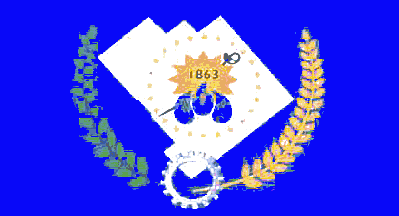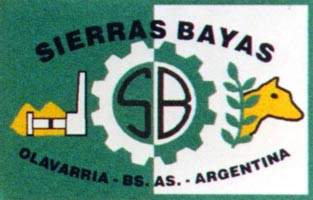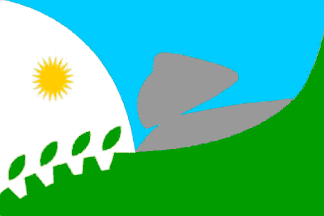
Last modified: 2006-08-19 by francisco gregoric
Keywords: buenos aires | provincia de buenos aires | alberti | avellaneda | nueve de julio | map | lagoon | drop | sun: 12 rays | saber | sword | stars: 24 | cogwheel | wreath | laurel | wheat | sierras bayas |
Links: FOTW homepage |
search |
disclaimer and copyright |
write us |
mirrors
The Buenos Aires Province is divided in 134 internal subdivisions, that are called "Partidos" (they could be translated into English as "Districts") instead of "Departamentos" (Departments) as they are called in all the other Argentine Provinces.
The local government of each "Partido" (District) is called "Municipalidad" (Municipality).
Francisco Gregoric, 13 Apr 2005
During General Perón’s second government (1952-1955), some elements of the Peronist emblem were adopted for the regional coat of arms of Alberti Municipality.
After Perón was deposed in 1955, all these emblems were forbidden by the Military Government.
Francisco Gregoric, 16 Apr 2005

A white flag with the municipal coat of arms at center. Below that the name of the district in white letters inside a blue ribbon appears.
Francisco Gregoric, 26 Feb 2006
During General Perón’s second government (1952-1955), some elements of the Peronist emblem were adopted for the regional coat of arms of Avellaneda Municipality.
After Perón was deposed in 1955, all these emblems were forbidden by the Military Government.
Francisco Gregoric, 16 Apr 2005


According to the electronic newspaper "El Sol", 29 June 2005, the new flag of the City of Campana, based on a proposal by Deputy Estela
Giroldi, will be unveiled on 6 July for the 120th anniversary of the
foundation of the city.
Campana is located a few kilometers north-west of Buenos Aires, the
capital city of Argentina.
Ivan Sache, 30 Jun 2005

A white flag with the municipal coat of arms at center. Below that the name of the district municipal government between lines appears.
Francisco Gregoric, 26 Feb 2006

The flag of Ensenada District was adopted in 1999
In the upper part the horizon line appears. Above it a sky blue stripe (Pantone 285U) with a yellow (Pantone 108U) raising sun.
In the middle the "ensenada" (inlet), the geographic element, that gives its name to the district appears. The point of the green part is Punta Lara (Cape Lara). The green color is defined as "Green Hill".
In the lower part of the same wide than the upper one a red (Pantone 185U) stripe. It stands for the blood of all people (indigenous and immigrants) and it is a symbol of fertile love and creative and supportive effort. Inside it has the name of the district "Ensenada" in capital yellow letters (Pantone 108U).
According to its legislation, the flag has a 12,5:19 ratio and the upper sky blue stripe and the lower red stripe are 3,5 ratio units wide.
Francisco Gregoric, 07 Feb 2006

A white flag with the municipal coat of arms at center and the name of the district
Francisco Gregoric, 26 Feb 2006

A green field with the with the red geographic shape of the district at center. The flag has a light blue and white border at fly and at the upper and lower sides.
Francisco Gregoric, 27 Feb 2006

At left the logo of the municipal government appears. The text inside it is "MI". It stands for "Municipalidad de Ituzaingó" (Ituzaingó Municipal Government), and the name of the district (Ituzaingó) appears at right. However reading both words together: "MI ITUZAINGÓ", it could also mean "My own Ituzaingó".
Below the smaller text is "Para toda la vida" (For all the life).
Francisco Gregoric based on information provided by Horacio Callegari, 30 Jan 2006
An article published on 2 January 2006 in the
local newspaper "Noticias Paceñas" [See here]
seems to indicate that a change in the flag is under way.
From what I have understood, the proposal presented on 22 December 2005
shall add to the flag a feather and a book as a syumbol of education.
The author of the paper seems to be ironic about the need of already
changing a flag that was adopted on 16 June 2005, presented to the
public on 20 June 2005 and to the President of the Republic on 8 August
2005, but has not been seen yet flying anywhere in the municipality.
Ivan Sache, 10 Jan 2006

A white flag with the municipal logo at center surounded by the name of municipal government of the district. The Partido de la Costa does not have a coat of arms, but a logo.
Francisco Gregoric, 26 Feb 2006

La Matanza District is the most populated district of the Province of Buenos Aires. It is located next to the City of Buenos Aires, capital city of Argentina.
The flag of La Matanza District was the result of a school contest made in 2004. More than 200 schools of the district participated in that contest. A jury chose ten designs that participated in a voting made by school children and young people.
There it was chosen the flag designed by Daniela Ayala and Carla Noemí Aquino, students of the Rural School No. 52 of the Virrey del Pino Town inside La Matanza District.
The upper blue part pays homage to the the Matanza River (the most important one in the district), and the lower white part is inspired by the National Flag. It symbolizes all things that must be done and are pure like the intentions of good men and women. At center a half sun appears like in the flag of the Province of Buenos Aires. It represents strength and power. Inside it and as a red heart there is a "Federalist Star" (the "Federalist Star" is a flower that has been the symbol of Federalism in Argentina since the 19 Century). At both sides of the flag there are green laurel branches that stand for hope.
quoted by Francisco Gregoric, 04 Feb 2006
[Editor’s note: this district is a subdivision located inside the Province of Buenos Aires, just a few kilometers from the capital City of Buenos Aires. Its symbols are related just to it, and are not intended for South Atlantic Islands]
According to an article published on the Argentinian website Reporterweb, the ninth anniversary of the creation of the Municipio (Municipality) of Malvinas [Argentinas], was officially celebrated on 15 June 2004 in Buenos Aires.
The main event of the celebration, presided by the commandant of the military garrison of Buenos Aires, was a military parade of the Argentinian Army. There was also a flag raising ceremony, during which the national flag, the flag of the Province of Buenos Aires and the flag of the Malvinas municipality.
A longer description of the ceremony can be read on the Reporterweb website: Unfortunately, no image of the flag raising ceremony is available on the website.
Ivan Sache, 19 Jun 2004
Other sites:
Its flag consist of blue background charged with its emblem.
Dov Gutterman, 18 Feb 2002
Information translated from a 9 de Julio website (dead link).
It is left unsaid that the white geometrical shape is the geographic
outline of the department (35°30'S 61°W), pointing north, as seen f.i. at
http://www.capraro.com.ar/images/MaterialDidactico/Mapas/provincias/buenosairesg.jpg.
António Martins, 08 Dec 2004

In 1995 during the 116 anniversary of Sierras Bayas a contest for a local flag was made. The proposal made by the girl Fiorella Nesci was chosen between more than 40 designs. The jury was formed by Mónica Ward y Mabel Mineo from the Plastic Arts School of Olavarría. The flag was presented the following year.
Francisco Gregoric 28 Feb 2006

The flag has two stripes, light blue and green with the geographic outline of the district at center with inverted colors (green and light blue). It also has a yellow raising sun.
Francisco Gregoric, 26 Feb 2006

A white flag with the municipal coat of arms at center and the name of the district
Francisco Gregoric, 26 Feb 2006

Adopted 9th December, 2003. The design, selected through a
competition, was designed by Daniela Delceggio.
Johnny Andersson, 08 Jul 2004
At http://www.cybertandil.com.ar/notas/20031210%20bandera.htm can be seen the flag of the city of Tandil, in Buenos Aires province, Argentina. There is the following text:
Se presentó la Bandera que representará a Tandil
El martes 9 de diciembre, a las 9.30, en el despacho del intendente, se llevó a cabo el acto mediante el cual se presentó oficialmente la bandera que identificará a nuestra ciudad.
En dicho acto, en el que estuvieron presentes el intendente, Ing. Indalecio Oroquieta, el director de cultura de la Municipalidad, miembros del Concejo Deliberante y del jurado, se exhibieron los 4 trabajos preseleccionados, otorgándose un primer premio, un segundo premio y dos menciones especiales. El jurado estuvo integrado por un representante del Ejecutivo municipal, un concejal, un diseñador gráfico, un historiador y por Mariano Asurabarrena, quien participó de la selección de la bandera bonaerense en su calidad de funcionario de la Secretaría de Cultura de la provincia de Buenos Aires.
El veredicto del jurado fue el siguiente:
1º PREMIO: Daniela Delceggio. Este trabajo ha sido seleccionado como la BANDERA OFICIAL.
It looks like it was adopted on 9 december (probably 2003, according to the adress of the webpage). Looking at the flag, it seems to have been somewhat inspired from the provincial flag (see the lower hoist).
Olivier Touzeau, 28 Mar 2004

The Partido de Tres Arroyos (Three Streams) is located in the southeast of the Buenos Aires Province. At the second half of the 19 Century the area was a place of fights between the indigenous people and the army. The city of Tres Arroyos was founded in 1884.
The flag of Tres Arroyos District was adopted in 2004. It was chosen in a contest where school children could participate.
The jury was formed by the Mayor Carlos Sánchez, the inspector-chief of Arts Education Nora Zaparart, the school counselor Mercedes Florez, the History Professor María Rosa Turienzo, and the artist Hugo Constanzo.
Finally the design made by Félix Golato and Lucas Gonzalo Ruggirello of the School No. 202 was chosen between 67 proposals.
The colors and design of the flag have the following meaning:

Each of the (15) stars represents one the towns inside the District. These towns are the following ones:
(*)[Editor’s note: 11 de Septiembre (September 11) is named that way because September 11, 1888 was the date when 19 Century President of Argentina Domingo Faustino Sarmiento died. As Sarmiento made several reforms in the Argentine Education system, then September 11 is "Teacher’s Day" in Argentina.]
Other sites:.gif)